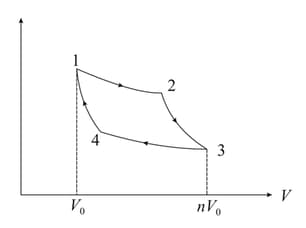Embibe Experts Solutions for Chapter: Thermodynamics, Exercise 4: Exercise - 4
Embibe Experts Physics Solutions for Exercise - Embibe Experts Solutions for Chapter: Thermodynamics, Exercise 4: Exercise - 4
Attempt the free practice questions on Chapter 17: Thermodynamics, Exercise 4: Exercise - 4 with hints and solutions to strengthen your understanding. Alpha Question Bank for Engineering: Physics solutions are prepared by Experienced Embibe Experts.
Questions from Embibe Experts Solutions for Chapter: Thermodynamics, Exercise 4: Exercise - 4 with Hints & Solutions
A thermally insulated, the closed copper vessel contains water at . When the vessel is shaken vigorously for , the temperature rises to . The mass of the vessel is and that of the water is . The specific heat capacities of copper and water are and , respectively. Neglect any thermal expansion.
How much heat is transferred to the liquid-vessel system?
How much work has been done on this system?
How much is the increase in internal energy of the system?
One gram of water becomes of steam when boiled at a pressure of one atmosphere. Latent heat of vaporization at this pressure is . Compute the work done.
A piston can freely move inside a horizontal cylinder closed from both ends. Initially, the piston separates the inside space of the cylinder into two equal parts, each of volume , in which an ideal gas is contained under the same pressure and at the same temperature. What work has to be performed in order to increase, isothermally, the volume of one part of the gas times compared to that of the other, by slowly moving the piston?
A cylindrical tube with adiabatic walls having volume contains an ideal monoatomic gas as shown in figure. The tube is divided into two equal parts by a fixed super conducting wall. Initially, the pressure and the temperature are on the left and on the right. When system is left for sufficient amount of time the temperature on both sides becomes equal (a) Find work done by the gas on the right part? (b) Find the final pressures on the two sides. (c) Find the final equilibrium temperature. (d) How much heat has flown from the gas on the right to the gas on the left?

An ideal gas having initial pressure and volume .
(a) The gas is taken isothermally to a pressure and then adiabatically to a pressure . Find the final volume.
(b) The gas is brought back to its initial state. It is adiabatically taken to a pressure and then isothermally to a pressure . Find the final volume.
Two samples and of the same gas have equal volumes and pressures. The gas in sample is expanded isothermally to four times of its initial volume and the gas in is expanded adiabatically to double of its volume. If works done in isothermal process is twice that of adiabatic process, then show that satisfies the equation
A Carnot engine cycle is shown in the figure (2). The cycle runs between temperatures Minimum and maximum volume at state and state are and , respectively. The cycle uses one mole of an ideal gas with . Here and are the specific heats at constant pressure and volume respectively. You must express all answers in terms of the given parameters and universal gas constant .

(a) Find for all the states
(b) Calculate the work done by the engine in each process
(c) Calculate , the heat absorbed in the cycle.
Cloud formation condition
Consider a simplified model of cloud formation. Hot air in contact with the earth’s surface contains water vapour. This air rises connectively till the water vapour content reaches its saturation pressure. When this happens, the water vapour starts condensing and droplets are formed. We shall estimate the height at which this happens. We assume that the atmosphere consists of the diatomic gases oxygen and nitrogen in the mass proportion respectively. We further assume that the atmosphere is an ideal gas, the acceleration due to gravity is constant and air processes are adiabatic. Under these assumptions one can show that the pressure is given by
Here and is the pressure and temperature respectively at sea level is the lapse rate (magnitude of the change in temperature with height above the earth’s surface, i.e. ).
(a) Obtain an expression for the lapse rate in terms of and . Here is the ratio of specific heat at constant pressure to specific heat at constant volume; , the gas constant; and , the relevant molar mass.
(b) Estimate the change in temperature when we ascend a height of one kilometre ?
(c) Show that pressure will depend on height as given by Eq. (1). Find an explicit expression for exponent in terms of .
(d) According to this model what is the height to which the atmosphere extends? Take and
